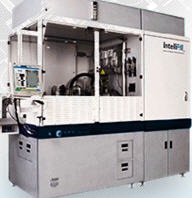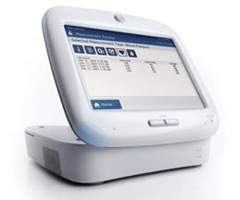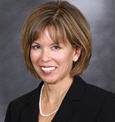From The PACS Designer: "Re: faster networks. Sentara Healthcare has installed 10-gigabit Ethernet adapters to improve network speeds with the advent of large file sizes coming from newer modalities. TPD can remember when 10BaseT Ethernet was the rule in the 1980s, so we’ve come a long way since then speed-wise. Back then, the talk was ATM (Asynchronous Transfer Mode) was to be the big thing in networking, but Ethernet overcame that thinking with faster adapter cards that everyone could benefit from without ripping out existing networks. Now, the recent talk has been about Converged Enhanced Ethernet (CEE), and Fibre Channel over Ethernet (FCoE) to provide 10-gigabit per second speeds for both storage area networks (SANs) and the Ethernet protocols." Link 1, Link 2.
From Vanessa Loring: "Re: Jordan. I heard that Perot won the contract to install WorldVistA in the nation of Jordan despite promising not to bid on the work since they were involved in the initial selection. The point was to keep them neutral so they wouldn’t recommend a system they would later sell. My source is reliable, but consider it an unsubstantiated rumor." The customer must have agreed to ignore the contact clause, either for good reason or because they were easy to convince. Good for Perot in any case.
From Popeye Doyle: "Re: RelayHealth/HealthVault. Did you see this connection announcement? RelayHealth physician/patient connectivity engine and Microsoft’s HealthVault for personal health records. Interesting play for both organizations." It’s hard to guess the scope and importance of the deal, so it’s not obvious whether this is just another of many services available to HealthVault users or something bigger. I’m sure we can get more information.
From Jailbird: "Re: Microsoft. Oh, language. Regarding your quote of Bill Crounse, of Microsoft Worldwide Health. His comment: ‘I think the speaker from HSG was misunderstood.’ Note he puts the onus on the listener. Not that the speaker was unclear or may have misspoken, but the listener may have been at fault. Says more about the attitude and atmosphere of a company than most anything else." This was from an HIStalk posting last week in which a reader reported that Microsoft’s Health Solutions Group told the audience that they were not part of Microsoft and had their own support mechanisms. User error? Doubtful. I agree … instantly blaming the customer without even asking the HSG people what they said is a little too pro-company for my taste.
From Puff Daddy: "Re: press releases. What happened to the days of old where you called out puff press releases? Just because they are a sponsor you give them a pass? You called out Misys last year." I ripped them because of the idiotic headline they put on their puff release, which led off with "The Momentum Continues:" which seemed right up there with "It was a dark and stormy night" except it deviated from the press release convention of pretending to sound objective. It was unremarkable otherwise. As far as sponsors go, I’ve said repeatedly that the only benefit they get is that I’ll sometimes give a brief mention to their not-so-newsy press releases, usually without further commentary.
SilenceOfTheLambs says that a corporate e-mail confirms that Kevin Smith, the alliance manager of Intermountain Health Care’s GE relationship, has left the organization. I’m not sure anonymous confirmations count, but there you go.
From The Atlanta Observer: "Re: McKesson. Territory shake-ups and delayed commission payouts seem to be causing an exodus of good sales and client service people from McKesson. Jay Deady at Eclipsys seems to be the real beneficiary since he can just keep the door open in his cross-town office without even needing a headhunter." Unconfirmed and sales people change all the time (from both companies, in fact, and probably for those same nearly universal reasons) so I’m not reading anything into it other than it’s tough to be in sales.
From Suziesales: "Re: pregnant saleswomen. [Name omitted] is laying off pregnant saleswomen about to go on maternity leave. Is this even legal? Seems you have to be a non-pregnant male to have job security at [vendor]." If an attorney wants to render an opinion I’ll run it here, although the details are skimpy. I’m leaving out the names of the manager and the vendor since I don’t know the story. I’m sure the legal answer will involve the layoff criteria, the mix of employees involved, and any FMLA complications (i.e., the company had better not be discriminating against pregnant employees, but on the other hand, pregnant employees aren’t supposed to get preferential treatment over equally qualified coworkers). You can’t be dismissed simply for being pregnant, obviously, and I can’t imagine an employer doing that (or admitting it, anyway).
From Franklin Rose: "Re: Sutter. California Pacific Medical Center – flagship affiliate of Sutter Health – will dissolve ties with its corporate parent. Lack of a good business case for Sutter’s $1 billion Epic implementation is a driving force behind the divorce, among other issues." Confirmation of that fact would certainly be interesting.
From CommonSense: "Re: heparin errors due to confusion between 10 units/ml and 10,000 units/ml concentrations of vials in routine use. New machines, barcoding everywhere, sounds like a bunch of techies. maybe we should just make the vials/syringes a different color." Bad idea, actually. Color-coded tops cause more errors than they solve — there are lots of drugs and only so many colors. The last thing you want a nurse to do is choose your critical drug by color, container shape, or other memory shortcuts. There’s only so many ways to fix a problem in which people don’t read the label (pharmacy staff in this most recent example). Confirmation bias is a big problem (i.e., I’m assuming this drug is right unless I see something wrong and even then I might disbelieve my eyes). I’m all for fixing problems in the simplest possible way, but technology is the only way to go here (and of an unusual kind: that which automates/checks processes inside the pharmacy, not at order entry or administration).
From Bob: "Re: OHSU. On 4/13, OHSU became one of the first academics (if not the first one) to go-live with Epic inpatient on time, on schedule and on budget. Six weeks later, CPOE was live in adult care areas."
From Winston Zeddemore: "Re: HIPPA. Another bozo ‘HIPPA’ eruption. From the good folks at iHealthBeat, nonetheless. Copied and pasted directly from my email: ‘HHS Fines Providence Health for Previous HIPPA Violations.’ Ouch! Here’s a link, if they haven’t fixed it already." The link is dead and the article is now here, so they did change it. One good thing about printed publications: they can’t just change their mistakes and pretend they never happened. However, searching their site for ‘HIPPA’ provides two previous articles where they made the same mistake and this particular goof is preserved courtesy of Google’s cache. Busted. I’m sure I’ve made a few howlers myself, although the ‘HIPPA’ one is nearly unforgivable (even more so than ‘HIMMS’, maybe).
From Wink Martindale: "Re: EMRs. Thought you’d appreciate Waegemann’s recent discussion on ‘The Wrong National Strategy for EMRs’" Link. Peter Waegemann of MRI (a private business, not a non-profit like you might have thought, as I mentioned recently) says we’re on the wrong track. I don’t see much original there, although he advocates cheaper, non-proprietary systems and rips CPOE a little. Minor gripe: he argues that we need to "give low cost systems a chance" even if not CCHIT-certified. They’re available, so what more chance do they need? Nobody says you have to buy CCHIT-certified systems and if the market wants cheap systems, they ought to be selling (the real problem is that the market doesn’t want systems at all if they are inconvenient and provide no ROI to the purchaser, so cheap isn’t cheap enough).
From Christopher Little: "Re: HIStalk. Your site – because of its freshness, relevance and unswerving dedication to the light of day – gets a lot of good traffic, based on the traffic we see from it. We are close to some first closed deals, even." Chris is VP of new HIStalk sponsor Loftware and has a strong HIT background, so when he e-mailed that comment to me, I shamelessly asked if I could quote him. And so I just did.
I’m back after my longest Internet-less hiatus ever. Inga did a super job not only keeping up with the usual stuff, but also bringing in some guest authors, don’t you think? I see lots of page views and comments. Thanks to Jonathan Bush, John Glaser, Mike Gleason, Frank Poggio, and everyone who commented. Guest articles are welcome even now that I’m back, should you care to write one (including those "What I Did on Summer Vacation" tales that Inga was soliciting). Thanks, too, to Wompa1, who got Inga all bedroom-eyes’ed with his instant classic, "Ode to Inga."
Listening: Radio Birdman, short-lived, mid-70s Australian indie/punk. Still soundin’ good in cyberspace as I air-bass along with the lads.
Here’s a tiny ethical dilemma I’m struggling with. A vendor CEO wants to write something for HIStalk and I’m sure it would make a good read. However, in the past, the company has refused to confirm reader rumors I’ve asked them about, saying they have a policy of not responding to blogs. I’ve also heard that they’ve warned their employees not to post to blogs (including this one) unless the marketing department has reviewed their postings. Would you run the piece?
Tiny ethical dilemma two: a vendor PR person asked us to interview the division CEO (it’s a conglomerate). Those don’t usually go well because those folks (no offense) are hardly trail-blazing original thinkers and contrarians, being more company careerists unwilling to rock the mega-boat by being quotable. But, to be nice, we said OK. The company then e-mailed back that, upon further review, the CEO only does top-level print publications and conferences (i.e., HIStalk isn’t worth that person’s time) but they would offer up a general manager. We said no, figuring we were doing them a favor in the first place. Should we have interviewed the GM?
Going back on time, Inga was trying to confirm that Medsphere is moving its headquarters from Aliso Viejo, CA. It is (or has already moved, I should now say). Our contact says rapid growth required a doubling of space, so they’ve moved to Carlsbad, CA.
Layoffs coming: Elsevier (Orlando, FL), 77 employees over the next year. Select Speciality Hospital (Conroe, TX), closing and laying off 85 employees today.
A UK government minister with a glass-half-full perspective says that the roster of vendors pulling out of NPfIT, most recently Fujitsu, is actually great news. "The fact that Fujitsu’s contract was terminated is in fact a sign of the programme’s strength. The programme is still on course and our contractors are not paid until they have delivered. In that sense, no money has been lost." Expressing a preference to keep the project money rather than have vendors meet deliverables suggests that NPfIT was a bad idea in the first place, not that politicians are the best source of astute analysis.
The local paper covers the ED tracking system of A.O Fox Memorial Hospital (NY), which appears to be McKesson’s.
It’s a travesty, at least according to the ambulance chasers: Florida doesn’t require doctors to carry malpractice insurance as long as they make that fact known and pledge to personally cover at least $250,000 in a malpractice award. That reduces lawsuits, which of course reduces lawyer incomes, so personal injury attorneys are warning patients to steer clear of those docs (as a purely humanitarian gesture, of course).
Daughters of Charity CIO Richard Hutsell gets a mention in the San Jose paper for rigging streaming video that allowed a hospitalized patient to see his son’s wedding and reception (what, no live honeymoon coverage?)
Scott Shreeve weighs in on the apparent DoD-led conniving to dump VistA in favor of vendor applications. Given that DoD has given big consulting firms billions of dollars to develop its AHLTA system, you can bet that lobbyists are whispering in a lot of political ears to make VA follow the big bucks model, which unfortunately trumps any consideration of VistA’s superior track record. The VA has made some boneheaded and ego-driven IT mistakes, but VistA isn’t one of them.
Old news by now, but I’m behind: athenahealth bags a deal to provide software to up to 200 RediClinic retail clinics located in Wal-Mart stores. Interested HIT Investor saw it coming.
Jobs: Pharmacy Requirements Director, SurgiNet Case Tracking Consultant, Systems Administrator, Software Engineer, Healthcare IT Sales, Director of Marketing, Legal/Healthcare.
Data and information provider Verispan, started by Quintiles and McKesson in 2002, sells out to rival SDI. The company was most recently known for whining about a New Hampshire law that would have stopped them from selling prescription data to drug companies.
In Australia, the Victorian Department of Human Services says a letter that claimed all but one hospital there didn’t want Cerner Millennium was a hoax. It was not said who perpetrated it.
Tyson Roffey is named CIO of The Children’s Hospital of Eastern Ontario. The article doesn’t say, but I think he used to be director.
RSNA is healthcare’s biggest trade show based on exhibit space (which is the most important measure of all, apparently). HIMSS is a distant second. Maybe that’s why HIMSS is moving to expensive, cold Chicago next year, hoping to sell endless McCormick Place boat show acreage to close the gap.
Hospital for Sick Children (Canada) is testing IBM software that will monitor a constant stream of neonatal physiologic monitor data, looking for early symptoms of infections.
Aurora Health Care (WI) goes live with evidence-based nursing protocols developed with Cerner and the University of Wisconsin-Milwaukee College of Nursing.
The first HIMSS Middle East Conference will be held in Bahrain in May 2009.
I received a Rumor Report about supposed implementation problems at an Ohio hospital that certainly don’t sound characteristic of the vendor involved, including cost overruns on the $100 million project. I’m not naming names without on-the-record confirmation, so first-hand reports are welcome.
A reader is researching companies that need to audit hundreds of medical records from a single provider offsite. How do you get those records, especially if the provider uses an EMR? If you have thoughts, let me know and I’ll pass them along.
Atlanta’s Grady Hospital still needs a CIO if you need a challenge.
MediSolution (Canada) will sell its healthcare information systems business to Healthvision. I don’t know much about the company, but they have order entry, care plans, a portal, CDR, departmental systems (lab, rad, pharm), registration, scheduling, and EMPI. If anyone knows more about their products, chime right in because that’s a pretty broad line.
Odd hospital lawsuit: a Sutter hospital sues an elderly patient for trespassing after the family declines to sign her release papers. Sutter says she’s been in there for a year already and is ready for another level of care, blaming the doctors who say she should be moved to a subacute facility (are those still around?) or a nursing home.
E-mail me.
HERtalk by Inga
Yippee! Mr. H is back! My biggest fear was that no one would be reading while he was out, so thanks to everyone for hanging with me the last couple of weeks. It was fun, but I am glad that the pressure is off!
As Gwen Darling of HealthcareITjobs.com suggested, I am keeping the HERtalk name for my little piece of HIStalk real estate. We’ll just say that the “HER” part of the name stems from Bill Gates’ preference for women over EHRs.
Park City Healthcare (UT) has selected (warning: PDF) iMedica’s EHR/PM solution for its 10-doctor practice. I am hoping that Mr. H’s new friend Michael Nissenbaum will ask me to go onsite to interview the physicians and staff about the implementation experience. I am sure I can find a couple days during ski season to check them out.
I realize some people could care less about hearing some ex-Congressman talk about anything, but I wouldn’t mind sitting in on Tom Daschle’s keynote at Misys’s upcoming conference. He’ll be stumping a new book and sharing wisdom about the current state of the healthcare industry and what needs to be done to curb spending and provide all Americans with access to high-quality healthcare. I’d rather hear that presentation than sit through some motivational speaker’s rah- rah about ways to live life more fully.
Perot announces Q2 earnings, which beat analyst estimates. Revenues were up 11%, though healthcare rose just 3%.
Rice Memorial Hospital (MN) selects MEDHOST’s emergency department software for electronic documentation.
MEDSEEK announces a 67% increase in new contracts for the first half of 2008 compared to last year. Fifteen new US and Canadian hospitals signed up for MEDSEEK’s enterprise portal solutions.
HIStalk reader and Ironman competitor Ed Marx of Texas Health Resources was one of 11 people named to the Texas Health Services Authority. The organization is responsible for coordinating a voluntary and secure electronic health information infrastructure for the state.
Eclipsys releases Q2 earnings and revenues were up 11% year on year. Excluding certain items, the company earned 24 cents per share, better than the predicted 23 cents. Things sound pretty rosy.
ACS announces a couple of big wins. The City of New Orleans EMS signs a five-year, $4 million contract to equip ambulances with FIREHOUSE Mobile EMS software. Chump change compared to the $100 million, five-year contract with UMass Memorial Healthcare. The UMass deal is for extensive IS services and extends an existing six-year relationship.
Earlier this week I noted that Crescent City Physicians in New Orleans was moving to Sage EHR/PM. New Orleans EMS is adding some technology, and now Ochsner Health Systems announces it will deploy Carefx’s interoperability platform Fusion for 15,000 users. Sounds like healthcare facilities finally have the funds, time, and energy for HIT three years post-Katrina.
Michael Leavitt tells a recent audience he believes blogging is a very powerful engine for public policy setting. Though he has his own blog, I’m sure he was really referring to all the policy shaping contributions from HIStalk readers.
On that note, I am cutting it short tonight. I’m back to relying on Mr. H for the heavy lifting, witty commentary, and musical selections.
E-mail Inga.














EHRMusing - You make a lot of accurate statements about key factors in the selection process but the comment about…